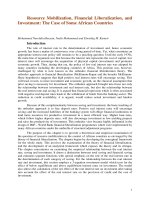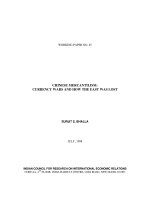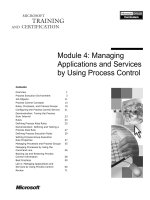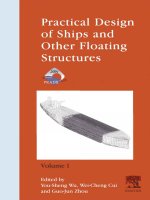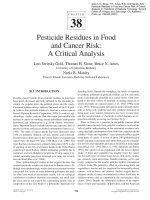Tài liệu Aging Aircraft - USAF Workload and Material Consumption Life Cycle Patterns pdf
Bạn đang xem bản rút gọn của tài liệu. Xem và tải ngay bản đầy đủ của tài liệu tại đây (1.08 MB, 221 trang )
R
Project AIR FORCE
Raymond A. Pyles
AGING
AIRCRAFT
USAF Workload and
Material Consumption
Life Cycle Patterns
Prepared for the United States Air Force
Approved for public release; distribution unlimited
RAND is a nonprofit institution that helps improve policy and
decisionmaking through research and analysis. RAND
®
is a
registered trademark. RAND’s publications do not necessarily reflect
the opinions or policies of its research sponsors.
© Copyright 2003 RAND
All rights reserved. No part of this book may be reproduced in any
form by any electronic or mechanical means (including
photocopying, recording, or information storage and retrieval)
without permission in writing from RAND.
Published 2003 by RAND
1700 Main Street, P.O. Box 2138, Santa Monica, CA 90407-2138
1200 South Hayes Street, Arlington, VA 22202-5050
201 North Craig Street, Suite 202, Pittsburgh, PA 15213-1516
RAND URL: />To order RAND documents or to obtain additional information,
contact Distribution Services: Telephone: (310) 451-7002;
Fax: (310) 451-6915; Email:
Library of Congress Cataloging-in-Publication Data
Pyles, Raymond, 1941-
Aging aircraft : USAF workload and material consumption life cycle patterns /
Raymond A. Pyles.
p. cm.
“MR-1641.”
Includes bibliographical references.
ISBN 0-8330-3349-2 (pbk.)
1. Airplanes, Military—United States—Maintenance and repair. 2.
United States. Air Force—Ground support. I.Title.
UG1243.P96 2003
358.4'183'0973—dc21
2003005775
Cover design by Barbara Angell Caslon
The research reported here was sponsored by the United States Air
Force under Contract F49642-01-C-0003. Further information may
be obtained from the Strategic Planning Division, Directorate of
Plans, Hq USAF.
iii
PREFACE
Throughout the 1990s and into this century, the United States Air
Force (USAF) has found it necessary to retain its aircraft fleets for
unprecedentedly long service lives. Current plans forecast keeping
portions of some existing fleets for as long as 80 years of service.
The safety, aircraft availability, and cost implications of that fleet-
retention policy are unknown. Project AIR FORCE’s Aging Aircraft
Project is conducting a wide range of studies to improve the Air
Force’s ability to foresee those implications and identify actions that
will mitigate or avoid some of the more severe consequences.
This study measures how the USAF aircraft fleets’ ages relate to
maintenance and modification workloads and material consump-
tion. It will provide the foundation for future estimates of the effects
of those activities on maintenance-resource requirements, aircraft
availability, and annual operating costs. Thus, it should be of inter-
est to force planners, maintenance production planners, mainte-
nance policy analysts, system program directors, and logistics and
cost analysts.
Planners can use the empirical and analytic results in this report to
forecast how workloads and costs may grow in both the near term
and long term. System program directors can use those results to
gain an integrated perspective of the end-to-end resource and bud-
get implications for their weapon systems. Logistics and cost ana-
lysts should be interested in how this analysis dealt with the wide
range of confounding factors that may affect the measurement of
age-related workload growth and in the way in which different pat-
iv Aging Aircraft
terns of growth are exhibited for different aircraft designs for differ-
ent categories of workloads and material consumption.
PROJECT AIR FORCE
Project AIR FORCE (PAF), a division of RAND, is the Air Force feder-
ally funded research and development center (FFRDC) for studies
and analyses. It provides the Air Force with independent analyses of
policy alternatives affecting the development, employment, combat
readiness, and support of current and future aerospace forces. Re-
search is performed in four programs: Aerospace Force Develop-
ment; Manpower, Personnel, and Training; Resource Management;
and Strategy and Doctrine. The research described in this document
was performed in the Resource Management Program.
Additional information about PAF is available on our web site at
/>v
CONTENTS
Preface iii
Figures xi
Tables xv
Summary xix
Acknowledgments xxvii
Chapter One
INTRODUCTION 1
Scope of This Study 3
Organization of This Report 4
Chapter Two
PREVIOUS RESEARCH ON THE RELATIONSHIP
BETWEEN AGE AND MAINTENANCE WORKLOADS OR
COST 5
Summary of This Chapter 5
Availability of Workload and Cost Data Hampered Most
Early Studies 7
Recent Studies Have More Data, but Cost Analyses
Have Been Confounded by Accounting Practices and
Changing Organizations 9
Some Studies Have Focused More Heavily on Workload
Data 12
On-Aircraft Workload Studies Consistently Found
Growth at Base and Depot 13
On-Engine Overhaul Workloads Grow as Engines Age 16
Few Analyses Have Addressed Aging Components 17
vi Aging Aircraft
Material Consumption May Increase with Workload 18
Modification Age-Related Cost Patterns Have Not Been
Analyzed 20
Assessment of Previous Research 20
Identifying Constant Versus Variable Growth Patterns . 22
Using Linear Versus Accelerating Growth Equations 22
Generalizing Across Fleets 23
Controlling for Calendar and Organizational Effects 25
Budgeting for Modification Life-Cycle Patterns 26
Chapter Three
A BROADER PERSPECTIVE: LIFE CYCLE PATTERNS,
NOT INEXORABLE GROWTH 27
Summary of This Chapter 28
Age Is Only a Correlate of Other Processes 30
How Maintenance Workloads May Increase as Aircraft
Age 31
Identifying Constant Versus Variable Growth Patterns . 32
Material Consumption May Grow Differently Than
Maintenance Workload 39
Linear Versus Accelerating Growth Equations Must Be
Considered 40
Generalizing Across Fleets Will Enable Forecasting of
Newer Fleets’ Workloads 40
Effects of Calendar and Organizational Transitions Can
Be Mistaken for Age 41
Modification Life-Cycle Patterns May Differ from
Maintenance Patterns 44
Designers’ Horizons Limit the Operational Usefulness
and Supportability of Their Original Designs 45
Changing Operational Requirements May Cause
Episodic System Modification Workloads 46
Chapter Four
ESTIMATING AGE-RELATED WORKLOAD AND
MATERIAL GROWTH: APPROACH 49
Summary of This Chapter 50
Workload and Material-Consumption Categories 51
Maintenance Workloads and Material Consumption
Were Categorized According to Work Content and
Maintenance Echelon 51
Contents vii
The Categories Reflect Three Activities: Modernization,
Operations and Maintenance, and Military Personnel
Training 52
Data Availability Varied by Workload or Material
Category 58
Data Availability Varied by Category 59
Analysis Approach Varied by Category 59
On-Equipment (Flightline) Data, Edits, and
Regressions 63
Off-Equipment (Component Repair) Data, Edits, and
Regressions 69
Base Periodic-Inspection Data, Edits, and Regressions . 71
Special Inspection Data, Edits, and Regressions 72
Depot-Level Reparables Cost Data, Edits, and
Regressions 72
General Stock Division (GSD) Material Cost Data, Edits,
and Regressions 75
Support Equipment Purchase Data, Edits, and
Regressions 76
Programmed Depot Maintenance (PDM) Workload
Data, Edits, and Regressions 76
Depot Engine Workload Data, Edits, and Regressions 80
Per-Aircraft Contractor Logistics Support Cost Data,
Edits, and Regressions 83
Per-Flying-Hour CLS Cost Data, Edits, and
Regressions 84
Depot-Level Reparables Purchase Data, Edits, and
Regressions 85
Historical Modification Workloads Data, Edits, and
Regressions 85
Chapter Five
AGE-RELATED WORKLOAD AND MATERIAL COST
GROWTH: FINDINGS 89
Summary of Findings 89
Most Aircraft Maintenance Workloads Grow as Fleets
Age, Although at Varying Rates 90
More-Expensive Aircraft Often Have Faster-Growing
Workloads and Material Consumption Rates 90
GSD Material Consumption Growth Decelerates as
Aircraft Age 91
viii Aging Aircraft
PDM Workload Growth Accelerates in the Third and
Fourth Decades of Service 91
Modification Workloads Do Not Grow, but They Surge
About Age 20 92
Other Processes May Hide or Exaggerate Age-Related
Effects 92
Findings for On-Equipment (Flightline) Workloads 93
No Deceleration Was Detected in On-Equipment
Workloads 95
Practical Implications of the Reduced On-Equipment
Regression Equation 96
Findings for Off-Equipment Workloads 101
No Deceleration Was Detected in Off-Equipment
Workloads 103
Practical Implications of the Off-Equipment Regression
Equation 104
Findings for Base Periodic-Inspection Workloads 108
A Stepwise Backward Regression Reduced the
Independent Variables 108
No Deceleration Was Detected in Base Periodic-
Inspection Workloads 110
Practical Implications of the Periodic-Inspection-
Workload Regression Equation 112
Findings for Special-Inspection Workloads 113
A Stepwise Backward Regression Reduced the
Independent Variables 116
No Deceleration Was Detected in Special Inspections 116
Practical Implications of the Reduced Equations 118
Repair-Cost Findings for Depot-Level Reparable
Components 120
A Stepwise Backward Regression Reduced the
Independent Variables 120
No Deceleration Was Found in DLR Repair Costs 120
Practical Implications of the Regression Equation for
DLR Repair Requirements 123
Findings for General Stock Division Material
Consumption 125
A Stepwise Backward Regression Reduced the
Independent Variables 128
Contents ix
Deceleration Was Statistically Significant in GSD
Consumption 129
Practical Implications of the Regression Equation for
GSD Requirements 130
Findings for Replacement Support Equipment
Expenditures 132
A Stepwise Backward Regression Reduced the
Independent Variables 133
No Deceleration Was Found in Replacement Support
Equipment Purchases 134
Practical Implications of the Regression Equation 136
Findings for Programmed Depot Maintenance
Workloads 138
A Stepwise Backward Regression Reduced the
Independent Variables 139
The Regression Found Significant Second-Order
Acceleration in Late-Life Programmed Depot
Maintenance Workloads 140
Practical Implications of the Regression Equation 141
Lead Fleet Age, Follow, and Intra-Mission-Design
Learning 144
The Counterintuitive PDM Interval Effect 145
A Possible Alternative Explanation and Prediction of the
PDM Workload Acceleration 145
Findings for Engine Overhaul Workloads 146
A Stepwise Backward Regression Reduced the
Independent Variables 148
The Regression Detected No Second-Order
Deceleration in Engine-Overhaul Workloads 148
Practical Implications of the Reduced Equation 149
Cost Findings for Per-Aircraft Contractor Logistics
Support 152
A Stepwise Backward Regression Reduced the
Independent Variables 153
The Regression Detected No Per-Aircraft CLS Cost
Deceleration 154
Practical Implications of the Reduced Equations 156
x Aging Aircraft
Cost Findings for Per-Flying-Hour Contractor Logistics
Support 158
A Stepwise Backward Regression Reduced the
Independent Variables 159
Practical Implications of the Reduced Equations 162
Findings for DLR Modernization 163
A Stepwise Backward Regression Reduced the
Independent Variables 165
The Regression Detected No Per-Aircraft DLR
Modernization Deceleration 166
Practical Implications of the Reduced Equation 167
An Alternative Interpretation 168
Findings for Time-Change Technical Order (TCTO)
Depot-Level Workloads 170
A Stepwise Backward Regression Reduced the
Independent Variables 170
The Regression Detected No TCTO Workload
Deceleration 172
Practical Implications of the Reduced Equations 175
An Alternative Interpretation 177
Summary of Major Age-Related Findings 177
Some Uncertainties Remain 178
Chapter Six
IMPLICATIONS 183
Six Strategies 183
Facing Demand and Supply Uncertainties 185
References 189
xi
FIGURES
2.1. Predictions of Linear and Compound Growth
Equations for the Second Design Life Diverge
Substantially 24
3.1. How Aircraft Aging May Relate to Flight Safety,
Aircraft Availability, and Support Costs 31
3.2. Different Maintenance Workloads May Exhibit
Different Patterns as Aircraft Age 38
3.3. Evolving System Requirements Trigger Episodic
Modification Actions as Aircraft Age 46
3.4. Aircraft Modifications May Fluctuate Widely as Fleets
Age 48
4.1. Most Regressions Used Both Pulse and Diminishing-
Ramp Variables to Detect and Measure Break-In
Effects 65
5.1. More-Expensive Aircraft On-Equipment Workloads
Grow Faster 98
5.2. Fighters’ On-Equipment Workloads Vary Widely for
Reasons Other Than Age 100
5.3. Cargo Aircraft On-Equipment Workloads Also Vary
Widely, but the Age Effect Is More Apparent 100
5.4. Off-Equipment Workloads for the More-Expensive
Cargo Aircraft Overtake Fighter Workloads at About
Age 30 106
5.5. Fighters’ Off-Equipment Workloads Vary Widely for
Reasons Other Than Age 107
5.6. Cargo Aircraft Off-Equipment Workloads Vary Widely
for Reasons Other Than Age 107
xii Aging Aircraft
5.7. Base Periodic-Inspection Workloads Do Not Increase
as Fleets Age 112
5.8. Fighters’ Periodic Inspections Vary Widely 114
5.9. Cargo Aircraft Periodic Inspections Also Vary Widely,
but Around a Higher Mean 114
5.10. Special Inspections for Fighter and Cargo Aircraft
Grow at Equal Rates 119
5.11. The Predicted Variability of Fighter Special-
Inspection Workloads Increases as Fleets Age 121
5.12. The Predicted Variability of Cargo Aircraft Special-
Inspection Workloads Also Grows as Fleets Age 121
5.13. DLR Repair Expenditures Grow Steadily as Aircraft
Age 125
5.14. DLR Repair Expenditures for Fighters Vary Widely 126
5.15. Variability in DLR Repair Expenditures for Cargo
Aircraft Increases Noticeably as Fleets Age 126
5.16. More-Expensive Cargo Aircraft Experience Greater
Initial Growth in GSD Consumption 130
5.17. Fighters’ GSD Consumption Becomes Less
Predictable as Fleets Age Past Age 30 131
5.18. The GSD Consumption of More-Expensive Cargo
Aircraft Becomes Highly Unpredictable After Age 40 132
5.19. More-Expensive Aircraft Experience Greater
Replacement-Equipment Cost Growth 136
5.20. Forecast Requirements for Fighters’ Replacement
Support Equipment Become Less Predictable After
Age 30 137
5.21. Forecast Requirements for Cargo Aircraft Fleets’
Replacement Equipment Become Less
Predictable After Age 40 137
5.22. Cargo Aircraft PDM Workloads Start Lower, but Grow
Faster Than Fighter Workloads 142
5.23. Fighter PDM Workloads Are Less Predictable in Both
Early-Life and Late-Life Periods 143
5.24. Cargo Aircraft PDM Workloads Are Also Less
Predictable in Both Early-Life and Late-Life Periods 143
5.25. The Linear Equation Forecasts Lower Workload
Growth After Age 30 146
5.26. Workloads for Augmented Engines Are Higher, but
Workloads for Heavier Engines Grow Faster 151
Figures xiii
5.27. Predicted Variability for Fighter Engine
Depot-Overhaul Workloads Increases as Fleets Age 152
5.28. Predicted Variability for Cargo Aircraft Engine Depot-
Overhaul Workloads Grows Also as Fleets Age 153
5.29. More-Expensive Aircraft Experience Faster Growth in
CLS Cost per Aircraft 157
5.30. Less-Expensive Aircraft CLS Costs per Aircraft May
Vary Widely 157
5.31. More-Expensive Aircraft CLS Costs per Aircraft May
Vary Even More Widely Than Those for
Less-Expensive Aircraft 158
5.32. Per-Flying-Hour Charges for Contractor Logistics
Support Increase over First Ten Years of Service
Life 163
5.33. Prediction Uncertainties for Contractor Logistics
Support Per-Flying-Hour Costs Increase for Older,
Less-Expensive Aircraft 164
5.34. Prediction Uncertainties for Contractor Logistics
Support Per-Flying-Hour Costs Increase Even Faster
for More-Expensive Aircraft 164
5.35. DLR Purchases Experience a Sharp Initial Peak,
Followed by a Steady Growth as Fleets Age 168
5.36. DLR Purchases for Less-Expensive Aircraft Fleets Are
Less Certain at Both Young and Old Ages 169
5.37. Uncertainties in DLR Purchases for More-Expensive
Aircraft Fleets Increase at Very Young and Very Old
Ages 169
5.38. DLR Modernization Costs May Stabilize or Even
Decline at Very High Ages 170
5.39. TCTO Workloads Stabilize After an Initial Unstable
Period, Then Surge at the Start of the Third Decade of
Operations 175
5.40. Fighters’ TCTO Workload Uncertainties Do Not Vary
with Aircraft Age 176
5.41. Cargo Aircraft TCTO Workload Uncertainties Do Not
Vary with Aircraft Age 176
5.42. TCTO Workloads May Decline as Fleets Age 177
xv
TABLES
4.1. Labor and Material Categories for Maintenance and
Modification 53
4.2. Data Sources for Maintenance and Modification
Workload 60
4.3. Aircraft Included in Analyses and Category for Which
Data Were Available 62
5.1. Age and Cost Affect On-Equipment Workloads in the
Full Regression 94
5.2. Age and Cost Interact to Affect On-Equipment
Workloads in the Reduced Regression 96
5.3. On-Equipment Workloads Do Not Decelerate 97
5.4. Age and Cost Affect Off-Equipment Workloads in the
Full Regression 102
5.5. Age and Cost Affect Off-Equipment Workloads in the
Reduced Regression 104
5.6. Off-Equipment Workloads Do Not Decelerate 105
5.7. Age Does Not Affect Base Periodic-Inspection
Workloads in the Full Regression 109
5.8. Age Does Not Affect Base Periodic Inspections in
the Reduced Regression 110
5.9. Base Periodic-Inspection Workloads Do Not
Accelerate or Decelerate 111
5.10. Age Affects Special Inspections in the Full
Regression 115
5.11. Age Affects Special Inspections in the Reduced
Regression 117
5.12. Special-Inspection Workloads Do Not Decelerate 118
xvi Aging Aircraft
5.13. Age Affects Depot-Level-Reparable Repair Costs in
the Full Regression 122
5.14. Age Affects Depot-Level-Reparable Repair Costs in
the Reduced Regression 123
5.15. Depot-Level-Reparable Repair Costs Did Not
Decelerate with Age 124
5.16. Age Affects GSD Material Consumption in the Full
Regression 127
5.17. Age Affects GSD Material Consumption in the
Reduced Regression 128
5.18. Deceleration in the GSD Material Consumption
Regression Was Significant 129
5.19. Age Affects Replacement Equipment Purchases in the
Full Regression 133
5.20. Age Affects Replacement Equipment Purchases in the
Reduced Regression 134
5.21. Deceleration in Replacement Equipment
Purchases Was Not Significant 135
5.22. Pure Lead Fleet Age and Lead Fleet Age Versus
Flyaway Cost Significantly Affected Programmed
Depot Maintenance Workloads in the Full
Regression 138
5.23. Pure Lead Fleet Age and Lead Fleet Age Versus
Flyaway Cost Significantly Affected Programmed
Depot Maintenance Workloads in the Reduced
Regression 140
5.24. Programmed Depot Maintenance Workloads
Significantly Accelerated with Age in the
Regression 141
5.25. Age Did Not Significantly Affect Engine-Overhaul
Costs in the Full Regression 147
5.26. Age Versus Engine Weight Significantly Affected
Engine-Overhaul Costs in the Reduced Linear
Regression 149
5.27. Engine-Overhaul Costs Do Not Significantly
Decelerate with Age 150
5.28. Age Affected Per-Aircraft Contractor Logistics Support
Costs in the Full Regression 154
5.29. Age Affected Per-Aircraft Contractor Logistics Support
Costs in the Reduced Regression 155
Tables xvii
5.30. Per-Aircraft Contractor Logistics Support Costs Did
Not Decelerate 156
5.31. Age Affects Per-Flying-Hour Contractor Logistics
Support Costs in the Full Regression 159
5.32. Age Affects Per-Flying-Hour Contractor Logistics
Support Costs in the Reduced Regression 160
5.33. Per-Flying-Hour Contractor Logistics Support Costs
Do Not Decelerate 161
5.34. Age Still Affects Per-Flying-Hour Contractor Logistics
Support Costs in the Reduced Regression with E-9A
Data Removed 162
5.35. Age Affected Depot-Level Reparable Purchases in the
Full Regression 165
5.36. Age Affected Depot-Level Reparable Purchases in the
Reduced Regression 166
5.37. Depot-Level-Reparable Purchases Did Not Decelerate
with Age in the Linear Regression 167
5.38. Age Did Not Affect Annual Depot TCTO Workloads in
the Full Regression 171
5.39. Age Did Not Affect Annual Depot TCTO Workloads in
the Reduced Regression 172
5.40. No Significant Deceleration Was Detected in the
Reduced Regression of Annual Depot TCTO
Workloads 173
5.41. Removing B-2A Data Yielded a Simpler TCTO
Workload Equation, in Which Age Was Statistically
Significant 174
5.42. Primary Study Results: Significant Age-Related
Growth Rates 179
5.43. Alternative Age-Related Growth Rates 180
xix
SUMMARY
The Air Force is now passing through a period of transition.
Throughout the Cold War, when the force-structure and force-age
profiles were roughly constant, Air Force planners and programmers
could rely on the retirement of older aircraft to free up the mainte-
nance funds and capacity for both newer aircraft and the growing
demands of the remaining aging fleets. Relying on retirement is no
longer a part of current plans for the force structure. Instead, some
aircraft fleets will have unprecedentedly long service lives. The
straight-lining (i.e., zero-growth forecasting) of maintenance-related
budget requirements beyond the next year or two underestimates
future maintenance requirements, often substantially. Since the U.S.
government uses a 6-year forecast to plan expenditures, those
longer-term maintenance-budget shortfalls can be resolved only by
reprogramming funds from other initiatives or accepting decreased
aircraft availability for operations and training. Near-term bud-
geteers and programmers need to know the consequences of funding
maintenance at various levels in the face of growing workloads.
But funding ever-increasing annual maintenance workloads and ma-
terial consumption is not the only problem. Maintenance requires
both human and material capital, which must be acquired and
trained, to develop the maintenance capacity needed for those
growing workloads. Facility and equipment upgrades may take two
to three years to develop. Once funds are available, hiring a new
employee and training him or her to a journeyman skill level takes
even longer. Expanding capacity by hiring contractors may take still
longer, because contractors face those problems plus a steep
learning curve when they accept an unfamiliar workload. Planners of
xx Aging Aircraft
maintenance workload capacity and personnel need to know the
approximate sizes of the workloads as much as six to ten years in
advance so that they can acquire funds in time to develop sufficient
capacity.
Finally, there is the problem of replacing an aircraft fleet because its
operating costs or its availability is no longer acceptable. Typical
lead times for developing and fielding an initial operating capability
for an aircraft design range from ten to 15 years. Once an initial op-
erating capability has been fielded, it may take ten to 20 more years
to replace a large fleet at modern production rates. Air Force force-
structure planners need to know when total operating costs or fleet
availability will reach unacceptable levels.
The analysis reported here proposes models for forecasting age-
related maintenance and modification workload and material con-
sumption patterns to aid capacity, funding, and force-structure
planners develop cost-effective, realistic plans to sustain older fleets
while evaluating cost-effective fleet-replacement plans.
ANALYTIC APPROACH
Two conceptual models of workload and material consumption
growth over aircraft service lives were posited, one for maintenance,
another for modification. The models build on previous research
into age-related maintenance and modification workload growth.
Both conceptual models allowed for both growth and decline at dif-
ferent ages, but the modification model allowed for episodic surges
when major modifications were required.
In contrast to the approaches in many previous studies, the analytic
approach used here sought to distinguish long-term age-related
growth from other life-cycle events that may obscure or exaggerate
measured workload growth. For example, during a platform’s early
life, “infantile” failures caused by design or manufacturing errors and
initial “honeymoon” periods, when many aircraft components have
not yet begun to fail, may change workloads dramatically, but they
may have little relationship to the cumulative effects of material
degradation as a platform enters its second and higher decade of
service. Alternatively, exogenous events, such as changes in ac-
counting systems, how the force is organized, size or posture of the
Summary xxi
wing or maintenance organization, skill levels, or maintenance
procedures, may also affect workloads and hide or exaggerate the
apparent effects of age.
In addition, most previous studies based their forecasts of future
workloads on either linear- or compound-growth equations. Over
the long periods now envisioned for retaining Air Force aircraft, the
two equations yield substantially different forecasts. Compound
equations imply continuously accelerating exponential workload
growth; the linear equation implies more-modest, constant growth.
Thus, it is important to test for the presence of acceleration in order
to forecast workloads far into the future.
To complicate the forecasting issue still further, the maintenance
conceptual model forecasts that, as a direct consequence of the
design-life limits introduced by the original design and manufac-
turing processes, total workloads and material consumption must
ultimately decelerate. If so, early- and mid-life growth may over-
estimate later-life growth. Again, we need to test the available histor-
ical data for that possibility in order to forecast far into the future.
Thus, the study used regression analysis to address five questions:
1. Do older fleets experience higher maintenance or modification
workloads and material costs?
2. If workloads and costs are higher, how rapidly do they grow with
age?
3. Do different platforms experience different rates of growth?
4. Do different maintenance activities experience different growth
patterns?
5. What are the prospects for continued growth? Will the growth
accelerate, decelerate, or remain the same?
The answers should make it possible to improve forecasts of future
maintenance and modification workloads and material consump-
tion, and their associated costs. To answer the questions, we exam-
ined life-cycle patterns for the following workload and cost-growth
categories:
• Base-level on-equipment (mostly flightline) maintenance
xxii Aging Aircraft
• Base-level off-equipment (mostly component repair) main-
tenance
• Base-level periodic aircraft inspections
• Base-level special inspections
• Base-level demands for depot-level reparable component repairs
(DLR repairs)
• Base-level consumption of General Stock Division (GSD)
material
• Base-level replacement of support equipment
• Planned programmed depot maintenance (PDM) of aircraft
• Planned depot engine overhaul
• Contractor logistics support (CLS), priced on an annual per-
aircraft basis
• CLS priced on a per-flying-hour basis
• Depot-level modifications installed as part of a Time-Change
Technical Order (TCTO)
• DLR replacement and modernization.
Data were not available to examine life-cycle workload and cost pat-
terns for the following:
• Unscheduled depot-level maintenance (UDLM; sometimes
called speedline maintenance), in which unexpected repairs are
made to damaged aircraft
• Over-and-above depot-level maintenance, in which defects
discovered during PDMs are repaired
•Modification-kit design and fabricate costs
• Software maintenance.
Multiple regression analyses were conducted for each workload and
material consumption category in turn, using available historical
data for multiple United States Air Force (USAF) aircraft. Depending
on the available data, control variables were entered for aircraft fly-
away cost, calendar year, major operating command, basic aircraft
Summary xxiii
mission (e.g., fighter, bomber, cargo), several break-in periods (e.g.,
infantile-failure or honeymoon periods), in addition to the aircraft
age and an age–flyaway cost interaction term. For engine workloads,
engine weight was used instead of flyaway cost. We used a stepwise
approach to eliminate statistically nonsignificant terms and so that a
simple linear relationship that retained any significant terms could
be identified.
A post-hoc test was then performed to detect any acceleration or de-
celeration. It added a second-order term centered on age 20 years.
That age was chosen to minimize any correlation between the linear
and second-order terms. If the second-order term was statistically
significant, acceleration (or deceleration) had been detected in that
workload or material consumption category.
Statistical tests (Cook’s distance and leverage) were also performed
to detect the presence of any data points that might have an undue
influence on the resulting equations. When those tests indicated
some possibility of undue influence, we removed the offending
points so that we could observe the effects on the stepwise regression
reductions. When those results yielded a substantially different rela-
tionship, both results were reported and the implications discussed.
LATE-LIFE GROWTH FINDINGS
1
Maintenance workloads and material consumption generally exhib-
ited late-life growth as aircraft aged, but the rate of that growth
depended on both the aircraft’s flyaway cost and the workload cate-
gory. Long-term, late-life growth was found in all base-level and
depot-level maintenance workloads and material consumption cate-
gories except base-level periodic inspections, per-flying-hour con-
tractor logistics support, and depot modification workloads.
Often, growth rates depended on the aircraft flyaway costs: More-
expensive aircraft experienced higher growth rates. Of course,
growth rates in engine overhaul workload depended not on aircraft
______________
1
See Chapter Five, “Summary of Findings” and “Summary of Major Age-Related
Findings” sections and Tables 5.42 and 5.43.
xxiv Aging Aircraft
flyaway cost but on engine weight: Heavier engines exhibited higher
rates of growth.
Little evidence was found for the accelerating growth implicit in the
compound-growth equations. The only exceptions were PDM
workloads, for which a second-order term centered on age 20 was
significant. This finding indicates that PDM workload growth does
accelerate, at least through the 40 years of experience available to
date.
Except for General Support Division (GSD) consumable materials, no
workload or material consumption category exhibited any late-life
deceleration. Even the GSD result may be illusory. The available
GSD data end about the age of the peak consumption. Thus the sec-
ond-order deceleration may only reflect a prolonged honeymoon
period for some long-lived consumable parts.
Finally, depot-level aircraft modernization workloads (TCTO work-
loads) exhibited a statistically significant surge during the period be-
tween 20 and 25 years of age. This surge may reflect the limits of the
designers’ ability to forecast operational performance requirements.
As a result, the Air Force may find it necessary to reinvest periodically
to keep retained aging platforms operationally viable as operating
environments evolve.
OTHER WORKLOAD AND COST FINDINGS
Where data were available, all workload and cost categories were af-
fected by differences across Major Operating Commands
(MAJCOMs; e.g., Air Combat Command, Air Mobility Command) and
early-life honeymoon or infantile-failure periods.
Such early-life transitions pose an especially difficult problem for
those who would predict later-life growth. This analysis found both
honeymoon and infantile-failure patterns, depending on the work-
load category. Honeymoon effects’ low initial workloads would
cause later-life growth rates to be overestimated; infantile failures
would cause such rates to be underestimated. In either case, fore-
casters of late-life workloads can improve their forecasts by
discounting such early-life transitions. (See Chapter Five “Findings
Summary xxv
for On-Equipment (Flightline) Workloads” section for an example of
both infantile failures and a honeymoon period.)
The causes of differences in base-maintenance workloads across
MAJCOMs cannot be determined from these data. While some of
those differences may reflect variations in operating environments or
maintenance philosophies, they may also reflect different reporting
practices. In any case, the large differences found in this study may
hide or exaggerate the effects of age in other studies, if the MAJ-
COMs’ fleets have different ages. (See Chapter Five “Findings for On-
Equipment Workloads” for an example of differences between
commands.)
IMPLICATIONS FOR PLANNING
2
Obviously, the growth rates and life-cycle workload patterns re-
ported here can be translated into estimates of future aircraft avail-
ability and cost, based on the planned evolution of the USAF force
structure. Work is under way to develop a long-term forecasting tool
suitable for future maintenance and modification costs for alterna-
tive force-structure plans. Computational approaches are also being
developed to forecast aircraft availability from aggregate mainte-
nance or workload data. Those improved forecasts are an essential
element for planning during the period of transition to an older force
through which the Air Force is now passing.
IMPLICATIONS FOR MAINTENANCE POLICIES AND
PRACTICES
3
Despite the analytic results reported here that should improve
workload and cost forecasts, considerable uncertainty remains about
how future maintenance and modification workloads may grow.
First, some statistical uncertainties are inherent in the forecasting
equations developed in this study. The size of those uncertainties
generally grows as one extrapolates beyond the ages at which the Air
Force has operated aircraft. This study estimates the size of those
______________
2
See Chapter Six, “Six Strategies” section.
3
See Chapter Six, “Facing Demand and Supply Uncertainties” section.

